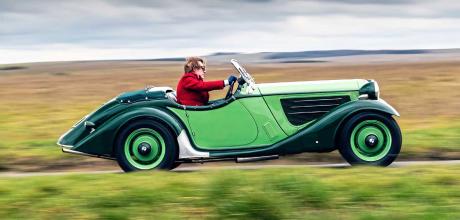1937 Frazer Nash-BMW 319/55 Sport
Frazer Nash-BMW may be a mouthful but the 319/55 proves small can be beautiful. We drive the 55bhp 1937 sports car that introduced a German juggernaut to the British market, setting off an improbable chain reaction.
Words EMMA WOODCOCK
Photography JONNY FLEETWOOD
The car that made Britain fall for Bavaria – the Frazer Nash BMW 319/55
From Tiny Acorns
Driving the Frazer-Nash 319/55 that began the UK’s BMW obssession
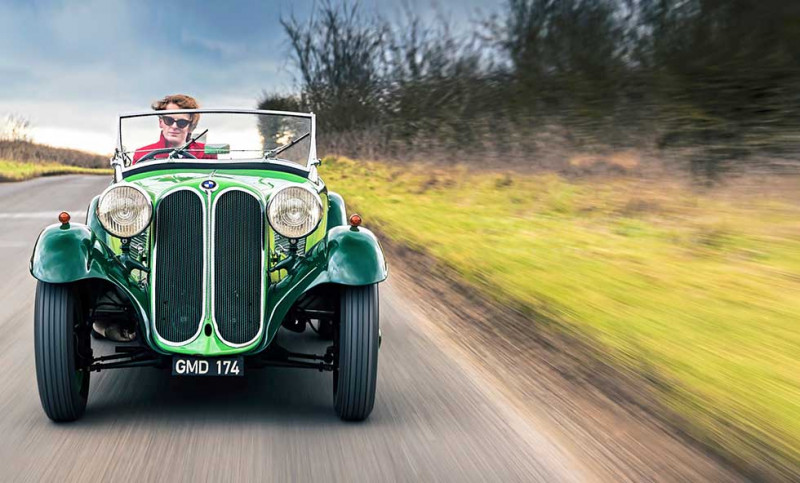
And they think today’s kidney grilles are big! Snorting through two huge, canted openings that cascade from the wheel centres to the spinal bonnet hinges, the 1937 Frazer Nash-BMW 319/55 Sport knows how to make an entrance. Streamlined from its integrated pontoon wings to its bee-sting rear, the latter cleverly designed to conceal a spare wheel, the roadster is the model of modernity. Strip away the aluminium coachwork and you’ll see lightweight tubular construction, cradling independent front suspension and rack-and-pinion steering. For HJ Aldington, one of the three brothers who owned Frazer Nash parent company AFN, this was the sports car of tomorrow. Goodbye to dated but effective home-grown chain-driven sports cars, hello to BMW imports.
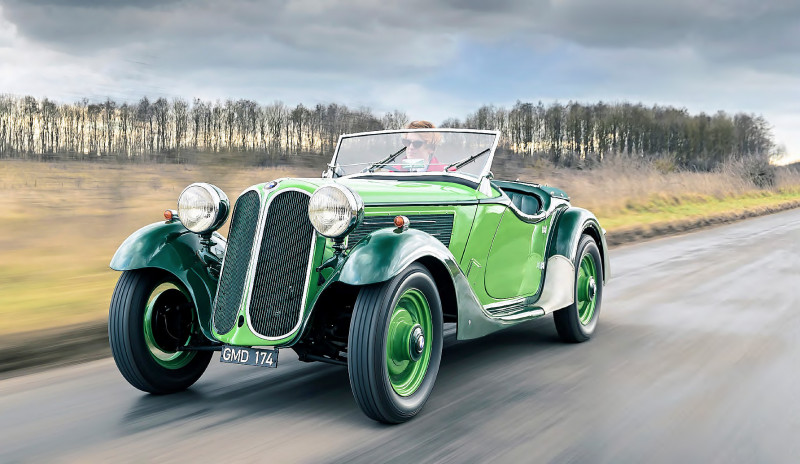
You can’t accuse arch-enthusiast ‘Aldy’ of prevaricating. The old school and the new era faced off at the 1934 Coupe Internationale des Alpes, one of the most prestigious rallies of the age, when Frazer Nash and BMW each fielded three works entries in the up-to-1500cc category. After five days of gruelling competition, the German team of 315/1 Sport cars won. Convincingly. Aldington responded by driving straight to Munich and convincing BMW head office to engage him as the company’s British sales agent. By December an agreement was reached, covering the rights to import and manufacture a full range of saloon, cabriolet and Sport models. Frazer Nash-BMW was born, with the first three digits (319 in this case) signifying BMW’s model number; the final two (55), Frazer Nash.
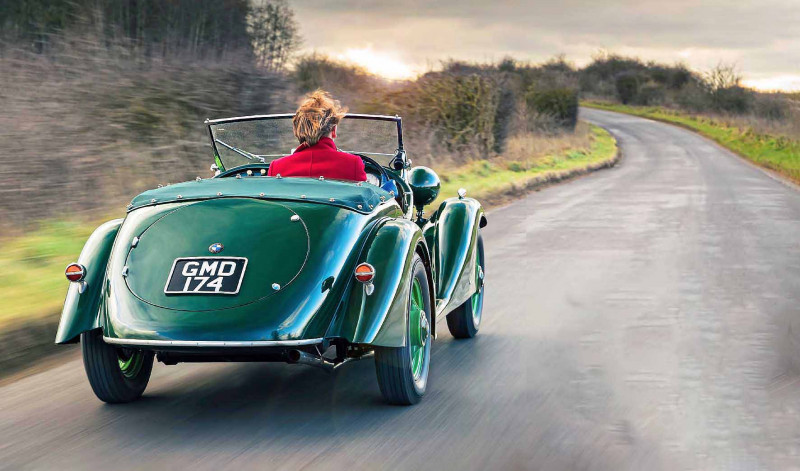
No matter the model, localisation changes were limited. UK-bound cars gained nothing more than right-hand drive, imperial dials and a FRAZER NASH BMW bonnet badge. Despite this, wedging myself aboard the 319/55 – a 1935-on development of the 315/1 with an extra 421cc and a leap from 40 to 55bhp – reveals the flyweight Frazer spirit. An upright, short-armed driving position greets me with a gigantic steering wheel and tiny cabin dimensions, all matching the homegrown TT Replica. There the similarities between the two end, the Nash-BMW offering the luxuries of a central gearshift and a driver’s door.
Stylishly cramped behind crisp Veigel dials and the rolltopped rim that wraps the cabin like a kayak hatch, one question remains before I can tug the choke, twist the centre-mounted key and thumb the starter. Just where are my legs meant to go? Forced either side of a wheel that grazes too close to the seat leather, my right knee crashes against the door release and my left occupies the same space as the gearlever, while the minute pedals can only be operated by the sides of my feet. I settle for dropping my hips and clapping my soles together, creating something that’s more birthing position than driving position, then forgive it all when I let that 1911cc inline-six rip.
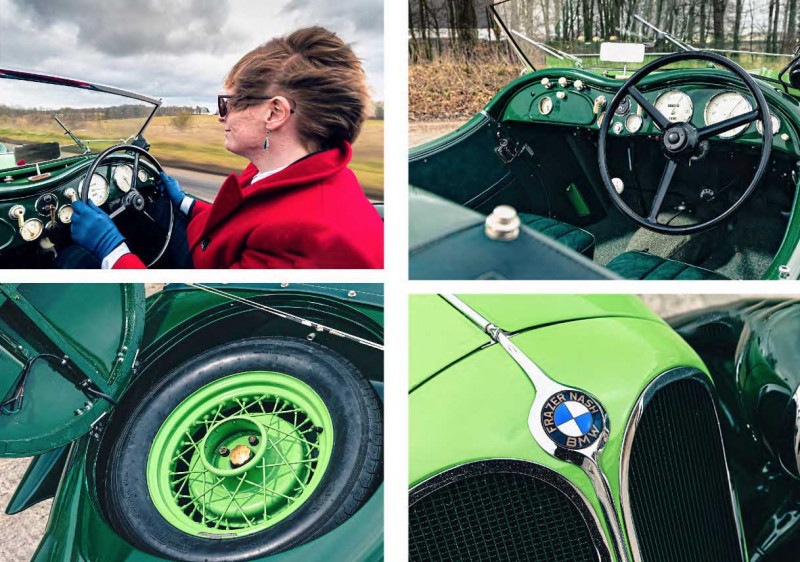
It catches in a sharp, bassy rip that jumps and falls as fast I can rock the pedal, then drops to a throaty growl when I lay the shifter down into second and pop the clutch through its short, positive throw. Picking up the throttle, the exhaust tears straight beneath my seat and I grin into the wind that’s starting to eddy around the windscreen. Sat low behind an endless bonnet, elbow dangling in the airflow and so far back that I’m almost over the rear axle, the Nash-BMW foreshadows a Lotus Seven’s talent for making even the slowest driving feel dramatic.
My route across Salisbury Plain provides more than ample staging. Acclimatising to the barely visible nearside front wing, I judge positioning via the headlights and shuffle gently towards the kerb, shocked that there’s so far to go. When I finally get there, the bitumen rushing to my right confirms that this minor road – where two modern hatchbacks can barely pass – has become a three-lane highway. At 1440mm wide, the entire car comes within 2cm of fitting within the track of a Derby Bentley.
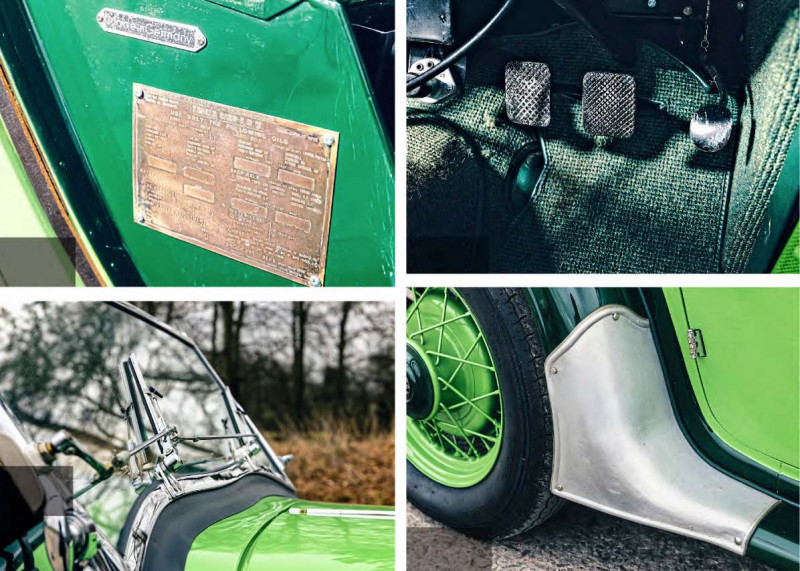
While I’m marvelling at dimensions, the Nash-BMW is growing bored with a steady speed cruise. The exhaust spits and grumbles on a steady throttle, the barely loaded rear axle bounces, and the steering – though joyously light and precise – is dead as driftwood. When I loosen my grip, the whole car spiders across the road, upright and uncertain, and tossed between compressions and cambers. It’s even whining, the straight-cut gear swamping the engine note with its mosquito hum.
Enough. I grab the shifter and push forward, holding the revs so the ratio releases cleanly, then feel it click against the neutral plane. A tight flick right and a faster, far less cautious punch throws the lever under the dashboard and into the slick embrace of synchromesh-equipped third. I push the throttle as far as it’ll go; the bonnet bucks skyward. The engine splits into layers of rising song, crisp intake bark dominating, the inline-six aligning in high, short rhythmic rips until it nudges 3500rpm and the exhaust re-enters the equation. Its flattened bass rockets from a whisper to dominant, ululating shout, then fires a revolver shot under my legs as I shift for a quick change to fourth.
It’s a joy, a riot, an Art Deco bagatelle with sudden, flooding appeal. And it’s still weaving around, bucking firm whacks from suspension to seatbase – only now the lines are sharper and the steering tighter, its rim throwing as much information at me as I can take. With only two turns between the lockstops, I’m a whirl of flicking wrists, constantly adjusting to stay on track but never nervous. Corners are a conversation, opened with a shoulder nudge and answered by the front wheels jumping at the action or demurring into understeer, sparking an adjustment that restarts the process time and again.
Clicking between the gears, matching revs and mastering the rush-wait-rush through the lengthy gate, the Nash-BMW and I chat our way through a series of tight, cascading bends. Through sharper sections, the ash-framed body lurches for just a moment, but the 749kg unladen weight means there’s little momentum to compound the roll, which quickly settles into a secure base to dance the car through with its quick, precise steering and razor-sharp throttle. I tuck in, chest close to the wheel, bracing my arms to scavenge even greater precision, feeling every bit the Goodwood escapee.
Period reports praised the scanty sports car. The Motor declared that ‘the constructional features and the road performance are quite out of the ordinary,’ while The Light Car analysed the ‘very interesting chassis’ and ‘unusual’ steering system. BMW had a modest hit on its hands, producing 230 315/1s and another 178 319/1s before production ended in 1937. Of these, just 42 were imported under the Frazer Nash scheme.
One of the few Brits to see the potential was Tom Dargue, amateur motor sport enthusiast and this car’s first owner, who embraced the marque in 1937. Specialising in the mudplugging, hill-climbing tribulations of trialling, he campaigned a Nash-BMW to Premier Awards on the Exeter, Land’s End and Edinburgh Trials – plus a brief diversion to snag second in a circuit race at Donington – before buying his own 319 in July. By October GMD 174 was taking home the silverware, winning a Premier Award at the MCC Sporting Trial in Buxton, Derbyshire.
Success continued unabated into 1938, car and driver snagging Premiers at the same four fixtures where Dargue had excelled the year before. A Club’s Cup for the best performance of any unsupercharged car at the Roy Fedden Trial further bolstered the trophy cabinet, while appearances on speed hill climbs and flat sprints underlined the car’s versatility. Along the way, GMD 174 received minor modifications, including front cycle wings and cut-back rears, steel wheels and the occasional installation of off-road tyres. Continuing into the next season, Dargue steered 319 to two more Premiers – at Exeter and Edinburgh – before pausing his racing career to get married.
After the war, three final trials bade farewell to GMD 174. After netting a First Class Award on the 1948 MCC Sporting, Dargue switched his attentions to entering the Monte Carlo Rally and constructing an MG-based sports racer. The Nash-BMW was sold, contesting a Silverstone VSCC race and the Brighton Speed Trials with its second owner before eventually passing to Lt Commander Morgan-Giles, who commissioned an extensive overhaul.
A series of enthusiast owners followed, from an architect who painted the car off-white and used it to tow motorcycles to an engineer who put the car through a decade-long renovation. By the turn of the millennium, Gloucestershire enthusiast Sandy Burnett had the keys. Replacing the rotten ash frame and steel bulkheads, repairing the original front wings, repainting the body from grey and red to its current two-tone green, and re-upholstering the cabin, he pursued a full-on restoration until he died.
Since then, the car has passed into the workshops of Spencer Lane-Jones for a two year programme of finishing touches. It’s now available at SLJ Hackett for £275,000. Throwing the shifter back into the embrace of fourth and stabbing the throttle to the floor, inlet biting and exhaust shouting, I think the Wiltshire specialist’s work rebuilding the gearbox and enhancing the engine to fast road tune was effort well spent.
So, it transpired, was Aldy’s dealmaking. The Sport was a fringe product but the rest of the Frazer Nash-BMW range attracted interest, netting more than 700 sales before the end of 1939. And HJ wasn’t done yet. Convinced of the cars’ superior engineering, he hunted out a local manufacturing partner, eventually using a Nash-BMW 327 to woo top brass at the Bristol Aeroplane Company. Bristol Cars was born in 1945, the new firm buying design papers from BMW to facilitate development of its first car, the 400.
Though the connection between Bristol and the Aldingtons wouldn’t last, part of their arrangement ensured the manufacture and supply of BMW-derived engines for a new range of Frazer Nash sports cars. Based on the inline-six used by the 1937-on 328 sports car – itself a development of the 319/55 unit – the motor would power iconic models such as the Le Mans Replica and Mille Miglia until 1954.
As that era finally drew to a close, the brothers once again looked to Germany for the future. What they encountered this time was emergent sports car manufacturer Porsche. AFN started selling the 356 in 1954, then became the marque’s UK concessionaire two years later. It was a role they’d hold for more than a decade, until HJ’s son John Aldington brokered a deal with Porsche to form Porsche Cars Great Britain. He went on to retain a substantial interest and serve as managing director of the new firm, before selling out in 1987.
The AFN name wouldn’t disappear until the 2000s; the dealership network continues to this day. A sales juggernaut got its start, a boutique British luxury car manufacturer received the expertise to build and develop its first several models, and a Brooklands-era survivor enjoyed twilight glories including a Sebring 12 Hour win, overall victory at the Targa Florio and third at Le Mans, all thanks to this tiny tearaway.
Barrelling along a sweeping A-road, tipping into curves with minimal inputs, feeling the seat slew round, drifting through and out of corners with heavy throttle and no steering lock at all, the 319/55 is a fluid, direct delight. You’ve got to hand it to Aldy – he knew the future when he saw it.
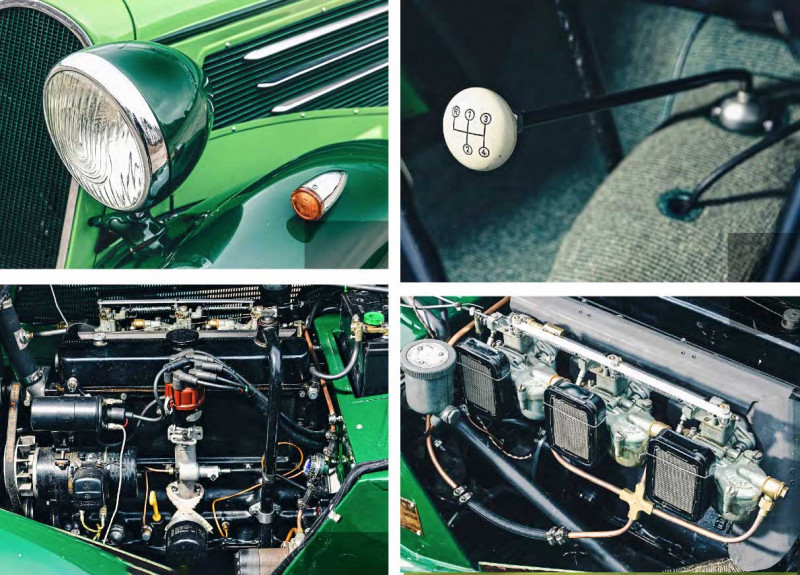
Meticulous foot positioning is essential Stoneguards sited at a would be hotspot for road-rash.
Plaques may have faded but the appeal of this car hasn’t. It’ll keep some of the wind off you some of the time.
First owner had great success in trials from 1937 to 1939.
Constant driver inputs are all part of the fun – of which there’s lots.
Huge headlights turn out to be handy cornering reference points Eager straight-six has received a fast-road tune Conventional H-gate shift is centrally mounted. Triple Solex carbs help give 55bhp.
That smile will stay there for the duration Full-size spare wheel ingeniously accommodated ‘More birthing position than driving position’ Bonnet badge denotes a UK-market car.
‘Corners are a conversation, opened with a shoulder nudge and answered by the front wheels jumping at the action or demurring into understeer’
TECHNICAL DATA 1937 Frazer Nash-BMW 319/55 Sport
- Engine 1911cc inline six-cylinder, ohv, triple Solex sidedraught carburettors
- Max Power 55bhp @ 3750rpm (torque figure unstated)
- Transmission Four-speed manual with synchromesh on third and top, rear-wheel drive
- Steering Rack and pinion
- Suspension Front: independent by transverse leaf spring, radius rods and integrated single-action dampers. Rear: live axle with semi-elliptic leaf springs and hydraulic lever-arm dampers
- Brakes Front and rear: Bendix cable-operated mechanical drums
- Acceleration 0-60mph: 15.2 sec;
- Performance top speed: 83mph
- Weight 749kg (1652lb)
- Fuel consumption 26mpg
- Cost new £475
- Asking price £275,000
RESTORING A FRAZER NASH-BMW 319/55
‘The Nash-BMW seems well made,’ say Lee Keller of Spencer Lane-Jones. He’s spent the last 18 months completing the restoration of this 319/55 prototype. ‘Especially compared to Hillmans and similar historic British cars I’ve worked on before. That shows in the way components were manufactured, and the how they fit together.
A lot of thought went into the design, which manifests in the precision of its construction. ‘The tolerances are definitely tighter than equivalent British cars. There are fewer bodges used to make the car work and much less shimming. Several parts are press-fitted, and their fitment is always just right. I only have to make adjustments of half-a-thou either way, if that, which really showed when fitting the gearbox. ‘It’s not just the engine that spans a decade or more to the Bristols; the suspension and the steering also carry forward, so you could say the Nash-BMWs were ahead of their time!’


